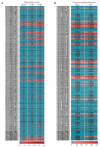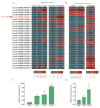A Novel Wall-Associated Kinase TaWAK-5D600 Positively Participates in Defense against Sharp Eyespot and Fusarium Crown Rot in Wheat
- PMID: 36902488
- PMCID: PMC10003040
- DOI: 10.3390/ijms24055060
A Novel Wall-Associated Kinase TaWAK-5D600 Positively Participates in Defense against Sharp Eyespot and Fusarium Crown Rot in Wheat
Abstract
Sharp eyespot and Fusarium crown rot, mainly caused by soil-borne fungi Rhizoctonia cerealis and Fusarium pseudograminearum, are destructive diseases of major cereal crops including wheat (Triticum aestivum). However, the mechanisms underlying wheat-resistant responses to the two pathogens are largely elusive. In this study, we performed a genome-wide analysis of wall-associated kinase (WAK) family in wheat. As a result, a total of 140 TaWAK (not TaWAKL) candidate genes were identified from the wheat genome, each of which contains an N-terminal signal peptide, a galacturonan binding domain, an EGF-like domain, a calcium binding EGF domain (EGF-Ca), a transmembrane domain, and an intracellular Serine/Threonine protein kinase domain. By analyzing the RNA-sequencing data of wheat inoculated with R. cerealis and F. pseudograminearum, we found that transcript abundance of TaWAK-5D600 (TraesCS5D02G268600) on chromosome 5D was significantly upregulated, and that its upregulated transcript levels in response to both pathogens were higher compared with other TaWAK genes. Importantly, knock-down of TaWAK-5D600 transcript impaired wheat resistance against the fungal pathogens R. cerealis and F. pseudograminearum, and significantly repressed expression of defense-related genes in wheat, TaSERK1, TaMPK3, TaPR1, TaChitinase3, and TaChitinase4. Thus, this study proposes TaWAK-5D600 as a promising gene for improving wheat broad resistance to sharp eyespot and Fusarium crown rot (FCR) in wheat.
Keywords: Fusarium pseudograminearum; Rhizoctonia cerealis; sharp eyespot; wall-associated receptor-like kinase; wheat (Triticum aestivum).
Conflict of interest statement
The authors state that there is no conflict of interest.
Figures






Similar articles
-
The Wheat Wall-Associated Receptor-Like Kinase TaWAK-6D Mediates Broad Resistance to Two Fungal Pathogens Fusarium pseudograminearum and Rhizoctonia cerealis.Front Plant Sci. 2021 Oct 27;12:758196. doi: 10.3389/fpls.2021.758196. eCollection 2021. Front Plant Sci. 2021. PMID: 34777437 Free PMC article.
-
TaWAK2A-800, a Wall-Associated Kinase, Participates Positively in Resistance to Fusarium Head Blight and Sharp Eyespot in Wheat.Int J Mol Sci. 2021 Oct 25;22(21):11493. doi: 10.3390/ijms222111493. Int J Mol Sci. 2021. PMID: 34768923 Free PMC article.
-
The Wall-Associated Receptor-Like Kinase TaWAK7D Is Required for Defense Responses to Rhizoctonia cerealis in Wheat.Int J Mol Sci. 2021 May 26;22(11):5629. doi: 10.3390/ijms22115629. Int J Mol Sci. 2021. PMID: 34073183 Free PMC article.
-
Genetics of Resistance to Common Root Rot (Spot Blotch), Fusarium Crown Rot, and Sharp Eyespot in Wheat.Front Genet. 2021 Jun 23;12:699342. doi: 10.3389/fgene.2021.699342. eCollection 2021. Front Genet. 2021. PMID: 34249110 Free PMC article. Review.
-
The escalating threat of Rhizoctonia cerealis, the causal agent of sharp eyespot in wheat.Pest Manag Sci. 2011 Nov;67(11):1411-9. doi: 10.1002/ps.2236. Epub 2011 Jul 1. Pest Manag Sci. 2011. PMID: 21726039 Review.
Cited by
-
Combination of linkage and association mapping with genomic prediction to infer QTL regions associated with gray leaf spot and northern corn leaf blight resistance in tropical maize.Front Genet. 2023 Nov 7;14:1282673. doi: 10.3389/fgene.2023.1282673. eCollection 2023. Front Genet. 2023. PMID: 38028598 Free PMC article.
-
Identification of genetic loci and candidate genes underlying Fusarium crown rot resistance in wheat.Theor Appl Genet. 2025 Jan 8;138(1):23. doi: 10.1007/s00122-025-04818-x. Theor Appl Genet. 2025. PMID: 39779539
-
TaHSP18.6 and TaSRT1 interact to confer resistance to Fusarium crown rot by regulating the auxin content in common wheat.Proc Natl Acad Sci U S A. 2025 Jul 15;122(28):e2500029122. doi: 10.1073/pnas.2500029122. Epub 2025 Jul 9. Proc Natl Acad Sci U S A. 2025. PMID: 40632559
-
Crown rot in wheat: pathogen biology, host responses, and management strategies.Stress Biol. 2025 Aug 25;5(1):52. doi: 10.1007/s44154-025-00247-4. Stress Biol. 2025. PMID: 40851052 Free PMC article. Review.
References
-
- International Wheat Genome Sequencing Consortium (IWGSC) Shifting the limits in wheat research and breeding using a fully annotated reference genome. Science. 2018;361:661. - PubMed
MeSH terms
Substances
Grants and funding
LinkOut - more resources
Full Text Sources
Research Materials

